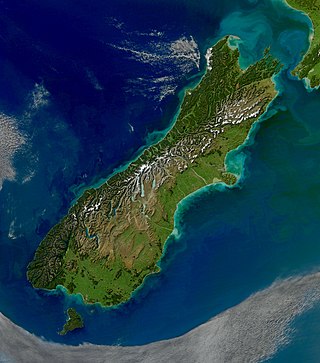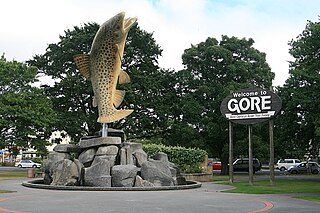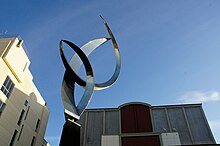
The South Island, also named Te Waipounamu in Māori, is the larger of the two major islands of New Zealand in surface area, the other being the smaller but more populous North Island. It is bordered to the north by Cook Strait, to the west by the Tasman Sea, and to the south and east by the Pacific Ocean. The South Island covers 150,437 square kilometres (58,084 sq mi), making it the world's 12th-largest island, constituting 56% of New Zealand's land area. At low altitude, it has an oceanic climate.

Gore is a town and district in the Southland region of the South Island of New Zealand. It has a resident population of 8,240 as of June 2023. Gore is known for its country music scene and hosts an annual country music festival. The town is also surrounded by farmland and is an important centre for agriculture in the region.

Invercargill is the southernmost and westernmost city in New Zealand, and one of the southernmost cities in the world. It is the commercial centre of the Southland region. The city lies in the heart of the wide expanse of the Southland Plains to the east of the Ōreti or New River some 18 km north of Bluff, which is the southernmost town in the South Island. It sits amid rich farmland that is bordered by large areas of conservation land and marine reserves, including Fiordland National Park covering the south-west corner of the South Island and the Catlins coastal region.

Bluff, previously known as Campbelltown and often referred to as "The Bluff", is a town and seaport in the Southland region, on the southern coast of the South Island of New Zealand. It is the southernmost town in mainland New Zealand and, despite Slope Point and Stewart Island being further south, Bluff is colloquially used to refer to the southern extremity of the country. According to the 2018 census, the resident population was 1,797, a decrease of 6 since 2013.

Wellington City Council is a territorial authority in New Zealand, governing the city of Wellington, the country's capital city and third-largest city by population, behind Auckland and Christchurch. It consists of the central historic town and certain additional areas within the Wellington metropolitan area, extending as far north as Linden and covering rural areas such as Mākara and Ohariu. The city adjoins Porirua in the north and Hutt City in the north-east. It is one of nine territorial authorities in the Wellington Region.

The Porirua City Council is the territorial authority for the city of Porirua, New Zealand.

Sir Timothy Richard Shadbolt is a New Zealand politician. He was the Mayor of Invercargill from 1998 to 2022, and previously Mayor of Waitemata City.
Scottish New Zealanders are New Zealanders of Scottish ancestry or who originate from Scotland. The number of New Zealanders who are descended from Scots is unknown, as the New Zealand census asks for ethnicity, not ancestry, and most have now assimilated; nonetheless, the vast majority of Pākehā, or European New Zealanders are of British and Irish descent, and it has been estimated that 1-2 million New Zealanders have roots in Scotland. This includes many Māori, as a large proportion of which have European roots as well. Most Scottish New Zealanders live in New Zealand's deep southern regions of Otago and Southland, New Zealand, where they have had a substantial influence. Scottish influence on Dunedin, one of New Zealand's most historically important cities was profound, and Presbyterianism is the major religion south of Christchurch. In some parts of Otago but all of Murihiku, there is a distinct accent known as the "Southland Brrr", which differs from mainstream New Zealand English for being strongly rhotic.
The Mayor of Invercargill is the head of the municipal government of Invercargill, New Zealand, and leads the Invercargill City Council. The mayor is directly elected using a First Past the Post electoral system every three years. The current mayor is Nobby Clark. Invercargill also has a deputy mayor that is chosen from the council. There have been 44 mayors so far.

Southland is New Zealand's southernmost region. It consists of the southwestern portion of the South Island and includes Stewart Island. Southland is bordered by the culturally similar Otago Region to the north and east, and the West Coast Region in the extreme northwest. The region covers over 3.1 million hectares and spans 3,613 km of coastline. As of June 2023, Southland has a population of 103,900, making it the eleventh-most-populous New Zealand region, and the second-most sparsely populated. Approximately half of the region's population lives in Invercargill, Southland's only city.

The Mayor of Carterton is the mayor of the Carterton District, which is administered by Carterton District Council, and earlier the office oversaw the Carterton Borough from 1887 until 1989, when Carterton Borough and Wairarapa South County were amalgamated to form Carterton District.
The mayor of Southland is the head of the municipal government of Southland District, New Zealand. The mayor is directly elected using the first-past-the-post electoral system. The current mayor is Rob Scott, who was elected in 2022.
The 2016 Invercargill mayoral election finished on Saturday, 8 October 2016 and was conducted under the first-past-the-post voting system using the postal voting system. It was held as part of the 2016 New Zealand local elections.
The mayor of Gore officiates over the Gore District in New Zealand's South Island. Prior to local government reorganisation in 1989, the mayor of Gore officiated over the Gore Borough.

William Benjamin Scandrett was a New Zealand politician. He migrated from England to New Zealand in 1855, and moved to Invercargill in 1862. He was the first town clerk of Invercargill after it was proclaimed a municipality, serving from 1871 to 1893. He was deputy mayor of Invercargill twice and mayor of Invercargill three times. Scandrett married Susannah Hinton Milstead and had five children.
The Water Services Reform Programme was a public infrastructure restructuring programme launched by the Sixth Labour Government to centralise the management of water supply and sanitation in New Zealand. It originally proposed shifting control of stormwater, drinking water and wastewater management from the country's 67 local councils to several new publicly-owned regional entities by July 2024. Details of the proposed reforms were announced in October 2021. The Three Waters reforms were criticised by several mayors and the opposition National and ACT parties.
The 2022 Invercargill mayoral election took place on 8 October 2022 as part of the New Zealand local elections. Incumbent mayor Tim Shadbolt unsuccessfully sought a tenth term against nine other candidates, losing to his deputy Nobby Clark.
William Stuart "Nobby" Clark is a New Zealand politician, serving as the Mayor of Invercargill since 2022. He has also served on the Invercargill City Council since 2019 and as deputy mayor since 2020.












